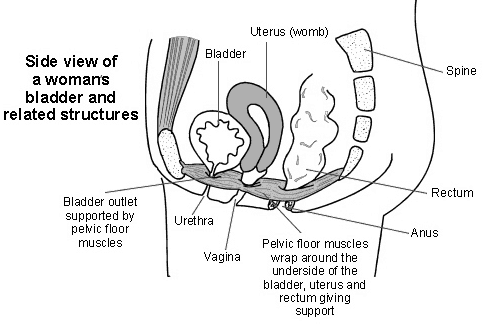Do you get light bladder leakage from time to time?
How do you manage it?
DID YOU KNOW: [list type=”icon-arrow”]
- The most common form of urinary leakage is called “stress incontinence” and it affects at least one in three ladies after having a baby.
- Leaking urine is usually caused by weakness in the pelvic floor muscles.
- The pelvic floor is a group of muscles that run between your pubic bone at the front and attach at your tailbone at the back. They are like a big hammock of muscular support that help support your bladder, uterus and bowel as well as keep your front passage (the urethra) and back passage (anal sphincter) closed. [/list]

Unfortunately for us women, these muscles undergo a lot of duress throughout our lifetime.
One of the biggest life events that stresses, damages and stretches our pelvic floor is pregnancy and childbirth.
Other risk factors that can contribute to weakness in these muscles include: [list type=”icon-arrow”]
- Age – muscle mass reduces after menopause.
- Chronic constipation
- Chronic coughing and sneezing (eg hay fever or respiratory illness)
- High impact exercise (eg running, heavy weight lifting, jumping)
- Obesity (particularly central obesity) [/list]
The good news is: there is plenty that you can do to improve your LBL!
Firstly:
Get fit!
20 minutes of low impact exercise, like brisk walking, everyday will help improve your overall health, postural muscle tone and will help drop some of those kilos that may be contributing to your leakage.
If you are overweight, losing 10% of your body weight will have a significant positive impact on your leakage.
Secondly:
Start doing those Kegel’s!
Strengthening your pelvic floor muscles is one of the key tips that will improve your leakage.
But it does require commitment! To strengthen your muscles you will have to take a few minutes out of your day everyday for at least 4-6 months to see a change in your symptoms.
Let’s get started!
First of all, start off in a lying position either on your side or on your back with your knees bent.
Gently tighten and squeeze the muscles around the vagina, back passage and front passage.
It should feel as if you are holding in wind or stopping your stream of urine.
Don’t hold your breath though! Keep breathing.
Try to hold those muscles on for as long as you can while you breathe, then relax.
Make sure those butt and thigh muscles are staying nice and relaxed during the exercise too!
How did you go?
Once you have the technique of contracting the muscles correct – try seeing how long you can hold a nice firm contraction on for before it fatigues and see how many you can do in a row before you simply can not do anymore.
You may start with only being able to do 3 second holds and 5 in a row. That’s ok! That’s where you start your exercise program!
The aim is to get up to a nice 8-10 second firm hold, be able to do 8-12 in a row and to practice the exercises at least 3-4 times a day!
When you feel ready, start to do the exercises in sitting and then standing.
Got it?
Don’t worry, sometimes it is a bit harder than it seems. If you are struggling to feel your muscles working or would like a more tailored exercise program – please book in to see us ASAP.
Now in order to make sure those muscles are going to stop you from leaking: squeeze them on tightly before you cough, sneeze, change position, lift or do any other movements that provoke leakage.
Finally:
Reduce those risk factors that weaken your pelvic floor further: [list type=”icon-arrow”]
- Avoid straining on the toilet to pass a bowel motion.
- Try to reduce the strain of coughing/sneezing by using adequate medication (antihistamines, asthma medications); support your perineum with your hands or by sitting before you cough/sneeze; talk to your physio about learning a “huff” technique to mobilise chest secretions.
- Limit heavy lifting as much as possible. Use good lifting ergonomics and tighten your pelvic floor prior to lifting.
- Swap your high impact exercise classes for something a little more gentle on your pelvic floor. Check out “Pelvic Floor First” website for more advice: www.pelvicfloorfirst.org.au or download their app onto your smart phone. [/list]
LBL – it can be fixed. Try implementing some of these tips today and you’ll feel the change in your confidence as your leakage reduces!
If you have any further queries or you would like a pelvic floor check up with our Pelvic Floor Physio, Mandy Roscher – call us on 3880 1649.
Alternatively:
Contact Us Here
